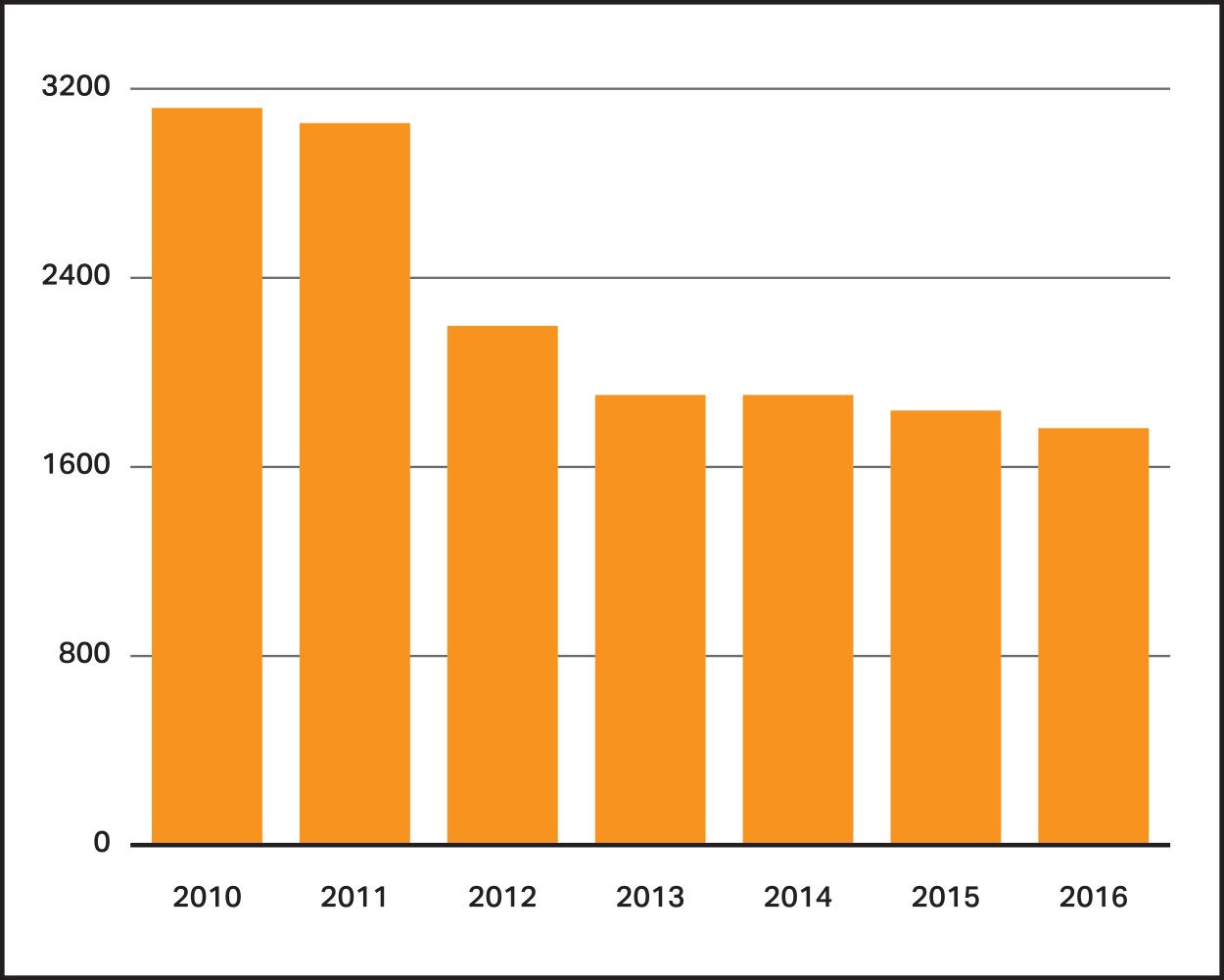Team Furey is determined to use the private sector to design, build, maintain, and finance – at least in part – new highway construction in our province. This approach is called a Public-Private Partnership or P3. Government’s standard practice for highway work is to issue an invitation to tender to the private sector to design and build a section of highway, government finances the project, and public-sector workers are responsible for maintenance, including snow clearing and ice control.
John Abbott, the Furey government’s Minister of Transportation and Infrastructure, says using a P3 will save money. And yet evidence from across Canada and around the world says the opposite is true. Evidence from provincial Auditors General across Canada also clearly shows that when private sector contractors are responsible for highway snow clearing and ice control, they cut corners to increase their profits – like taking longer to clear the highway (up to 2 times longer!) and using less ice control materials, resulting in reduced safety and more accidents.
According to Abbott, his decision is based on the success of previous P3 projects in the province. Yet recently inspectors found thousand of deficiencies in two desperately needed long-term care facilities built using P3s in Gander and Grand Falls-Windsor, which delayed their opening by more than a year.
Simply put, P3s cost more and cut corners to increase profits for big corporations. And when highway maintenance is privatized, snow clearing takes longer and less ice control materials are used, resulting in more accidents. When things go wrong, we’re the ones who bear the burden.
No matter how you look at it, P3s are highway robbery.
Tell your MHA No!
You can send an email
So what exactly is a P3?
Public-Private Partnerships or P3s are long-term contractual arrangements between a government and the private sector. They are a form of privatization – moving delivery of public services into the private sector. In a P3, the private sector typically finances, designs, builds, operates, and maintains infrastructure projects that have traditionally been funded by government, such as hospitals, long-term care facilities, schools, prisons, and highways. The services provided by P3s often include those traditionally delivered by public-sector workers. In theory, P3s include a level of risk sharing between the public and the private sector.
The European P3 experience
P3 advocates claim the private sector brings financing, efficiency and innovation. A major European study has revealed a different picture.
1. P3s create hidden government debt. The government pays the private-sector contractor over many years. And sometimes the taxpayer also pays the private-sector contractor directly through user fees like highway tolls. Governments like P3s because the debt does not appear on their balance sheets, making them seem more fiscally responsible.
2. Private finance costs more than government borrowing (typically two times as much).
3. Governments still bear the ultimate risk of project failure.
4. P3s don’t guarantee better value for money.
5. Efficiency gains and design innovation can result in corner-cutting.
6. P3s do not guarantee that projects are delivered on time or on budget.
7. P3 deals aren’t transparent, which can contribute to corruption.
In Europe, the financial crisis of 2008-09 caused many agencies to re-examine the use of P3s. Since then, the use of P3s in Europe has decreased substantially.
In the UK, where P3s have been enormously popular, some projects have been returned to the public sectors. In some others, some of the profits have been clawed back.
Why should we care about using P3s to build and maintain highways?
In a CBC story that aired on February 15, 2024, Newfoundland & Labrador’s Minister of Transportation and Infrastructure, John Abbott, revealed his plan to have the provincial government enter into a Public-Private Partnership or P3 in which the private sector would design, build, possibly finance, operate, and maintain a 40-kilometre section of twinned highway from Whitbourne to an area west of Bellevue, and a 15-kilometre stretch from Grand Falls-Windsor to Bishop’s Falls. Between them, the federal and provincial governments have already committed more than $300 million for the project.
Abbott said a request for proposals will be issued later this year to find private corporations (or consortiums of private corporations) interested in a 30-year agreement, with construction set to begin in 2025. According to CBC, Abbott also hinted there would be more P3 highway projects to come.
According to Abbott, his decision is based on the success of previous P3 projects in the province. Yet recently inspectors found thousand of deficiencies in two desperately needed long-term care facilities built using P3s in Gander and Grand Falls-Windsor, which delayed their opening by more than a year.
John Abbott also called P3s “a creative way of getting best value for money.”
Yet when the Government of Alberta was looking to redevelop part of Calgary’s Deerfoot Trail, which is maintained by the provincial government, it initially looked at using a P3 but decided against it because of the higher cost. Instead, government chose to finance the project itself.
And when Nova Scotia used a P3 to finance, build, operate, and maintain the Cobequid Pass Highway, it cost twice what it would have cost using traditional public procurement methods. And the private contractor ended up subcontracting snow clearing to Nova Scotia’s Department of Transportation.
In fact, traditional public procurement methods are often cheaper than P3s. In traditional public procurement, government issues a call for tenders for private-sector contractors to build public buildings and highways. The government provides the financing, and public-sector workers operate and maintain the infrastructure.
Many Canadian governments continue to promote P3s as a way to save money, ignoring 5 provincial Auditors General and multiple reports that say P3s cost more, in part because the private sector pays twice what governments pay to borrow money.
Governments also like to claim that using P3s transfers risk to the private sector when in fact governments often ends up assuming all the risk. That’s exactly what happened when Carillion – a major force in the field of P3s – went bankrupt leaving the governments of Alberta and Ontario scrambling to find a replacement to clear their highways of snow – regardless of cost.
Governments also claim P3s deliver better quality, yet those same 5 Auditors General found P3s often deliver less and lower quality. Private contractors often cut corners to increase profits, resulting in lower quality and public safety concerns.
Governments like how P3s allow them to transfer borrowing for major projects from their balance sheet to their private-sector partners. This makes the government seem more fiscally responsible. Yet taxpayers are still the ones footing the bill – for decades – and the bill is far bigger than it would have been if government had financed the project.
Using P3s allows governments to wash their hands of responsibility for public services. And unlike governments, which answer to taxpayers, their private-sector partners answer only to shareholders.
P3s also allow governments, which are supposed to be transparent and accountable, to cloak information in secrecy by claiming it is commercially sensitive, providing more opportunities for corruption and fraud. The $22.5 million corruption scandal arising from the $1.4 billion contract to build McGill University Hospital is one of many examples.
P3s use tax havens to avoid paying Canadian taxes
In 2016, 4 P3 corporations, which between them owned or partially owned 22 Canadian P3 projects, made $981.5 million in profit on those projects. These projects included schools in Alberta and an ambulatory care centre in Vancouver.
At the time, HICL Infrastructure Company Ltd., John Laing Infrastructure Fund Ltd., and International Public Partnerships Ltd. were all headquartered in Guernsey, a known tax haven, while Bilfinger Berger Global Infrastructure SICAV was headquartered I Luxembourg, also a known tax haven.
Not only does this revenue leave Canada, on that $981.5 million in profit, the 4 corporations paid $1.2 million in Canadian corporate income tax for 2017 – just 0.12% of their profits.
The information was uncovered in the course of a 2017 study by European Services Strategy Unit.
Finding out what P3 corporations pay in Canadian corporate tax is made difficult by two things. First, how easy it is to set up an anonymous company in Canada. And second, the secrecy governments allow to exist surrounding P3s and other forms of privatization.
When the governments privatize maintenance of existing highways, research – and experience – have shown it’s still not a good thing for the travelling public.
Ontario, British Columbia, Alberta, and Quebec have privatized 80% or more of their highway snow clearing.
In each province, government promised privatization would deliver cost savings and higher quality of service. The evidence suggests that almost without exception, the opposite has been true. Cost only goes down when contractors are allowed to take longer to clear highways and use less salt and other materials – resulting in significant safety concerns.
When a private-sector contractor can’t do the job
One of the most recent news stories that draws the wisdom of privatizing highway snow clearing into question involves the collapse of UK-based Carillion PLC in January 2018.
It is significant that Jennifer Wells, business columnist for The Star, wrote that Carillion’s collapse shows the limits of our drive to outsource public services.
One week after the collapse of its parent company, Carillion Canada filed for creditor protection in Ontario. At the time of the insolvency, Carillion Canada held contracts to maintain 40,000 kilometres of highway in Alberta and Ontario.
Carillion held three of eight Alberta highway maintenance contracts making it responsible for roughly 43% of Alberta’s highways. It controlled more than 300 snowplows – approximately half the snowplows working on Alberta highways — and employed about 300 workers during the winter and up to 500 during the summer months.
In March of 2018, the Government of Alberta announced it would provide up to $8.9 million to help Carillion Canada continue its highway maintenance operations, pay its employees, and continue doing business with suppliers in that province.
According to government, the cash injection was to ensure there was no disruption in snow clearing through to the end of April. The money also covered outstanding amounts Carillion owed to other vendors.
In August, a bankruptcy court awarded the three Carillion contracts in Alberta to another company. One contract was extended, while the Alberta government agreed to pay out $2.75 million more for each of the other two contracts. Total value of all three contracts was $482 million.
Carillion already had a rocky history in Ontario. On multiple occasions, it was slapped with fines for failing to perform its contractual obligations to clear the province’s highways.
In September 2017, prior to the collapse of its UK parent, Ontario’s MOT announced it was terminating Carillion’s road-maintenance contracts effective September 2018 and retendering them. Carillion held 8 of 20 winter road maintenance contracts in Ontario. The 11-year contracts, valued at roughly $1.2 billion, weren’t due to expire until 2023. Carillion’s collapse early in January of 2018 left Ontario in a precarious position.
Canada’s Experience with privatizing highway snow clearing
Ontario began privatizing highway maintenance in 1996. In 1999 Ontario’s Auditor General found private road maintenance was costing $2 million more than when it was a publicly delivered service. Measures designed to reduce the cost resulted in slower clearing of highways and reduced use of salt and other materials used for ice control.
British Columbia privatized highway maintenance in 1988. A study carried out for the province in 1994 found that costs actually increased by $19 million per year in 1992-93 constant dollars.
Alberta began privatizing highway maintenance in the late ‘80s. By 1995-96, highway maintenance was completely privatized. No serious study was undertaken to compare the cost of public versus private delivery of highway maintenance in Alberta. In fact, no one, including the province’s Auditor General, has the mandate or the access to examine the consequences of privatization.
Quebec’s snow clearing contractors have been convicted of price fixing, yet allowed to continue providing snow clearing services. They have also been cited for numerous safety violations. Until a media exposé, they provided little to no training for their snow plow operators (who are not required to hold a special class of license).
Several other province’s have dabbled in privatizing aspects of highway maintenance. Often, as was the case in Manitoba, the provincial government sets the stage by refusing to fill hundreds of vacant positions creating a false ‘need’ to contract out.


Ontario
Ontario – The Herb Gray Parkway P3
In Ontario, P3 consortium Windsor-Essex Mobility Group installed 320 concrete girders in the Berb Gray Parkway that did not meet the Canadian Highway Bridge Design Code. An independent review commissioned by Ontario’s Ministry of Transport (MTO) found the girders might be subject to cracking. As well, it found issues with how the reinforcing bars were welded to the girders. MTO later admitted to CBC that it knew the girders were not up to code in late December, 2012, before they were installed, yet installation continued until July 2013.
As opposed to replacing approximately 500 girders, MTO chose to salvage them by reinforcing the ones not yet installed and closely monitoring the condition of the ones already used.
Windsor-Essex Mobility, responsible for designing, financing, constructing, and maintaining the parkway over 30 years, disagreed with the findings of the independent report; however, they accepted the additional measures so they could resume work on the project.
Privatizing highway maintenance
In 1996 the Government of Ontario began to privatize highway snow clearing services. It said privatization would save the government at least five per cent compared to the public sector cost. But a 1999 provincial Auditor General’s report revealed that of the first four maintenance contracts, three actually cost $2 million more than having the public sector do the work. It also found that after awarding highway maintenance contracts, MOT hired the contractors to perform additional work without going to tender.
As well, the Auditor General found the MOT sold off snow clearing equipment, paid for by taxpayers, to private contractors for pennies on the dollar without going through the required public auction. This helped ensure it would be next to impossible to return highway snow clearing to the public sector.
At the time, MTO purchasing officer, George Kerhanovich, speculated that “Perhaps the biggest danger to taxpayers from managed outsourcing is that MTO equipment gets given away at fire-sale prices. It’s happening now. Contractors are picking up MTO plows and trucks for a song. Taxpayers are not getting fair value.”
By 2000, Ontario had fully outsourced all its highway snow clearing. In 2009, the MOT introduced a new performance-based contract model in an effort to reduce overall expenditures.
Under this new model, contractors are not required to use the MOT’s historically proven best practices to determine things like the type and amount of equipment to keep the highway system safe.
Companies won contracts without having enough equipment to fulfill them. They cut costs by short-changing on salt, sand, and other materials. And it took them twice as long to clear the highways.
Investigations uncovered hundreds of shortcomings. Companies were fined but often failed to pay the fines, and yet they were allowed to continue to do the work, and they were paid for it.
Even more significant than the financial losses from privatization were the safety issues noted by the Auditor General: “There were concerns that individual patrol areas were too large to adequately monitor the work of contractors to ensure that provincial highways were safe, usable and protected from untimely deterioration.”
In January of 2014, the MTO revealed that three highway maintenance companies in the northwest had been fined for failure to meet service standards. The MOT would not say how much the fines were, and a contractor said the company was not allowed to comment publicly on maintenance issues. This in itself confirms a common criticism of government contracts with private companies: they allow both governments and contractors to hide information from the public about how public funds are spent.
Provincial investigations in 2012-13 and 2014-15 uncovered more than 300 cases where private contractors failed to provide proper winter road maintenance services.
Road maintenance contractors were fined more than $47 million by the Ontario government over a five-year period for failure to provide services. According to the MOT, some of the fines may have been reduced or waived by the government.
Carillion Canada faced $900,000 in fines for failing to properly clear the QEW of snow and ice during storms in November and December 2014. The MOT investigation into the 2014 storms found Carillion was late in deploying snow clearing and de-icing equipment, and did not apply enough salt on the highway. Carillion was also investigated by the MOT after a series of accidents in Peel and Halton regions on New Year’s Day 2016. The MOT was checking to see exactly when the company dispatched salt spreaders and how much salt was applied on the Queen Elizabeth Way and on sections of Highways 400, 401, 403, 410, and 427 during a January 1, 2016 storm. About 20 accidents were reported on highways west and north of Toronto that day.
In a special report on winter highway maintenance, Ontario’s Auditor General found that by 2015 Ontario was saving money on road maintenance contracts but at a cost that included taking twice as long to clear highways of snow or ice than it did previously – nearly five hours in some cases. She also reported that private road maintenance companies were using insufficient salt and de-icing fluid.
As recently as March 2014, the Ontario government was reported to be reconsidering the privatization of winter road maintenance in the province after a report from Global News raised questions about road safety. A poll released to Global News suggested more Ontarians than not feel road quality in the province is getting worse.
Personal injury lawyers contacted Global News suggesting both the government and private contractors could be opening the door to litigation if safety standards are not maintained in road maintenance.
The Minister of Transportation at that time suggested that the government was looking at a potential overhaul of the privatized system.
If we’re going to manage the liability on behalf of the people of Ontario . . . then I would rather have that done directly by the public sector who is directly accountable to the legislature and the people of Ontario than a contractor who at this point in time has not met the terms of the contracts they’ve signed.

British Columbia
Review of 17 P3 Projects
A Columbia Institute study reviewed information from 17 P3 projects, included 3 that involved roadways, undertaken by Partnerships BC, worth $18.2 billion (the projects for which information could be obtained at the time). It found the projects cost $3.7 billion more than they would have had they been done using traditional government procurement methods.
The Sea-to-Sky Highway P3
In 2003, British Columbia entered into a P3 agreement to construct the Sea-to-Sky highway – at the time the largest road construction project ever undertaken in the province. Partnerships BC, the government agency charged with facilitating the development of P3 infrastructure projects in the province, conducted a value-for-money analysis, which found the P3 model would cost $46 million more than using the conventional government procurement process (where the private sector designs and builds, government finances, and public-sector workers maintain. The BC government chose to go the P3 route anyway.
An independent value-for-money analysis conducted in 2006 predicted the P3 approach would actually cost $220 million more over the life of the agreement. According to the author, Partnerships BC exaggerated the cost to taxpayers under the public option and double-counted the benefits the P3 approach would provide. For example, Partnerships BC inflated the cost of government borrowing by over 2.5 percentage points. Partnerships BC included this amount served to account for the cost to government of assuming all the project’s risk. Yet Partnerships BC also included a $10 million annual adjustment for risk in its calculation.
In 2009, the year the project was completed, an article in the Vancouver Sun made the following observation: “If the province were to have upgraded the highway and continued to maintain it as a totally public project, it would have cost $300 million less over the 25-year life of the deal.”
Privatization of highway maintenance
Highway maintenance in BC was privatized in 1988. Since then BC’s highway network has been maintained by private firms hired by the province. The independently prepared 1994 “Burton Report” found cost increases to highway maintenance program, concern over long-term preservation of highway assets, and decreased competition.
The 1991 Minister of Transportation and Highways in British Columbia stated his plan to undertake “a thorough review of the privatized road and bridge maintenance program to ensure that the taxpayers of British Columbia are getting good value for their dollars and that high standards of service are maintained.” The subsequent study found that costs had actually increased by $19 million per year in 1992-93 constant dollars.
A report also found that the more visible, cosmetic work was being done more extensively than the less visible preventative maintenance work, to an extent that the highway infrastructure was at risk over the long term.

Alberta
Alberta – No P3 for Deerfoot Trail improvements
When the Government of Alberta was looking to redevelop part of Calgary’s Deerfoot Trail, which is maintained by the provincial government, it initially looked at using a P3 but decided against it because of the higher cost, choosing to finance the project themselves.
Privatization of Road Maintenance
Up until the mid-1980s, the Province of Alberta carried out all the maintenance on its primary highways. The maintenance of secondary highways, resource roads, and local roads fell under the jurisdiction of the municipalities. Throughout the mid- to late 1980s and the early 1990s, the government gradually expanded the role of contractors in the maintenance of its primary highways. In 1995-96 it decided to outsource all the maintenance to private contractors.
Although there were a couple of attempts, no one actually carried out a comprehensive study to determine if privatization of highway maintenance in Alberta had been cost effective. So in 2002, the Parkland Institute undertook a review to determine if the switch to private highway maintenance had resulted in lower costs for the Alberta government while maintaining the same level of service.
According to the study’s authors: “[P]rivatization in any form – as presently constituted under Alberta’s privacy laws and the secrecy practiced by the government itself, represent a genuine problem of public accountability . . . Neither consulting firms, contracted by the government, nor the Auditor General of Alberta are mandated to examine the consequences of privatization”.

NEW BRUNSWICK
Privatization of Highway Maintenance
A 2019 report issued by New Brunswick’s Auditor General, Kim MacPherson, found that decisions made by the Department of Transportation and Infrastructure to outsource road and bridge construction and maintenance were “supported by an objective analysis of costs and consequences.”
In fact, “the Department outsourced work at the taxpayer’s expenses to support the private sector.”
According to a CBC story, the Attorney General’s report supported claims by a public-sector union that the “government was playing politics with people’s livelihoods, trying to fulfill campaign promises to boost the private sector by cutting jobs within the public service.”
The report also referenced the following as the kind of information the Government of New Brunswick should have taken into consideration before deciding to privatize highway maintenance:
- Events in other jurisdictions have highlighted the risks in outsourcing critical construction and maintenance work.
- The recent bankruptcy of Carillion Group of Companies highlights this risk (referring to the Governments of Alberta and Ontario left scrambling to find contractors to provide winter highway maintenance).
- A special report by the Ontario Auditor General in 2015 on the Ministry of Transport’s outsourcing of winter highway maintenance, which “created significant safety concerns both among the general public and for those delivering emergency services such as the Ontario Provincial Police (OPP).”

NOVA SCOTIA
Cobequid Highway P3
When Nova Scotia used a P3 to finance, build, operate, and maintain the Cobequid Pass Highway, it cost twice what it would have cost using traditional public procurement methods. And the private contractor ended up subcontracting snow clearing to the provincial Department of Transportation.

Québec
While it is difficult to determine what percentage of highways in Québec are maintained by private sector contractors in any given year, a few things are perfectly clear.
- The number of people employed by the provincial ministry of transportation has declined steadily – between 2009-10 and 2015-16, it fell by 41%. There have been additional cuts since.
- There is a shortage of qualified snow plow operators in Québec.
- Québec does not require snow plow operators to have a special license or specialized training, but at least public sector snow plow operators receive specialised training.
- Snow clearing contractors in Québec did not provide specialized training to their snow plow operators until pressured to do so as a result of a media exposé.
- There is no limit on the number of hours a private sector snow plow operator can work in a given day in Québec.
- Private snow-clearing contractors in Québec have been convicted and fined for price fixing but allowed to continue providing highway snow clearing services to the province.
- In 2015-16, the ministry of transportation issued 95 notices of reprimand to subcontractors “for breaches that compromised public safety.”
- Following a highway snow clearing disaster, the minister responsible for transportation at the time vowed to return at least 50% of highway snow clearing to the public sector but was unable to hire enough qualified snow plow operators to meet that commitment.
- A 2017 report by Québec’s Auditor General revealed the department, which contracts out 95% of its work, was unable to determine it was getting the best price available or to ensure the quality of the work being done. Small firms were often excluded from the process, and cost estimates were not being conducted properly.
A case study of private-sector snow clearing in Québec
On March 17, 2017, despite two days’ warning about a pending snow storm, Roxboro, a private contractor, failed to properly clear a section of the highway, which led to hundreds of people being stranded for as much as 13 hours. Many ran out of gas and had to abandon their vehicles. Yet two days before the incident, Environment Canada had issued a special weather statement, followed by a storm watch advisory and a storm warning issued on the day before.
According to a report released by Québec’s transportation ministry in the summer of 2017, Roxboro did not have the number of snowplows it was obligated to have on the road leading up to the Highway 13 pile up. Roxboro’s contract required them to have at least six snowplows on the road on snowy days. On the day in question, Roxboro only had three plows in operation during the day and five during the evening. The report does not assign blame to Roxboro. Nor does it state the company should have had more plows on the road. It merely states that Roxboro failed to meet its contractual obligations.
When asked to clear a corridor to allow evacuation of the trapped drivers, Roxboro had no equipment available. (Roxboro was one of five private contractors convicted of price fixing in 2000.) Efforts by provincial government employees to block access to ramps leading to the highway were stymied because the provincial ministry of transportation had failed to call in extra workers.
Ultimately Roxboro was fined $3,000 by Quebec’s Transport Ministry. According to a departmental spokesperson, the fine was levied “for failure to have minimal resources and equipment during the snowstorm.”
The provincial government paid towing fees for motorists who had run out of gas. Motorists filed a class action lawsuit, naming the provincial police, the transport ministry, and Montréal’s civil security. Victims asked for $2,000 each plus material damage. Ultimately the lawsuit was settled for $2 million, with victims receiving between $300 and $1,000 each.
In response to this incident, the minister of transportation promised to return 50% of highway snow clearing to the public sector but was unable to do so because of a shortage of snow plow operators available for hire. As recently as 2019, at least one opposition member has called on the provincial government to return highway snow clearing to the public sector. The premier launched an independent investigation of the incident. Two senior provincial officials were stripped of their duties, and Roxboro lost the contract.
Ministry of Transportation Workforce

SOURCE: ministère des Transports
Since then, Treasury Board instructed the ministry of transportation to cut 389 additional full-time equivalent (FTE) employees.
Contractors reprimanded for compromising public safety
In 2015-16, the MTQ issued 95 notices of reprimand to subcontractors “for breaches that compromised public safety.” MTQ’s spokesperson refused to share these notices with Le Devoir, telling the paper it could request them under access to information legislation.
In Québec, private snow plow operators are not required to have any special training or to be licensed. There is also not limit on the number of hours they can be required to work in a day.
In March 2019, an opposition MNA called on the Government of Québec to return all highway snow
clearing to the public sector. He was reacting to a video report published by The Tabloid, which showed that many private-sector snow plow operators receive practically no training when they are hired. They also do not have a specific license or a limit on the number of hours they work.
In the public sector, employees are trained before being hired as snow plow operators, but still are not legally required to hold a special license – a legal vacuum in the industry.
According to the opposition MNA, 80% of snow removal in Québec is entrusted to the private sector.
In response to the Tabloid exposé, the association representing Québec’s private snow-removal contractors said it would put a new training program in place.

GOVERNMENT OF CANADA
The Champlain Bridge P3
Infrastructure Canada signed a P3 contract worth just under $4 billion to design, build, finance, operate, and maintain a new Champlain Bridge. The new bridge was supposed to be finished by December 1, 2018. In January of 2018, Canada’s Auditor General issued a report on the project, which found that, among other things:
Infrastructure Canada completed its analysis of the procurement models for the new Champlain Bridge project two years after it announced it would be using a P3. This was despite the fact that before deciding to use a P3, federal organizations are required to perform qualitative and value-for-money analyses based on the practices established by PPP Canada.
The Auditor General found that Infrastructure Canada’s value-for-money analyses were of little use to decision makers because they contained many flaws favouring the P3 model. The project involved significant risks, was of unprecedented size, and required an accelerated schedule. The Auditor General determined the values used in the analysis were not sufficiently conservative.
In the end, the Champlain Bridge, built using a P3, was $325 million over budget and 6 months late.
SOURCES:
Roberts, Terry. (15 February 2024). New N.L. divided highway will be a P3 project, and NAPE crews won’t be welcome. CBC. https://www.cbc.ca/news/canada/newfoundland-labrador/highway-divided-nape-1.7114715
Lysyk, Bonnie. 2014 Annual Report. Office of the Auditor General of Ontario. http://www.auditor.on.ca/en/reports_en/en14/2014AR_en_web.pdf
McCarter, Jim. 2008 Annual Report. Office of the Auditor General of Ontario. http://www.auditor.on.ca/en/reports_en/en08/ar_en08.pdf
Bellringer, Carol. (November 2014) 2014 Summary Financial Statements and the Auditor General’s Findings. Office of the Auditor General of British Columbia. http://www.bcauditor.com/sites/default/files/publications/2014/special/report/AGBC%20ROPA-FINAL.pdf
Lapointe, Jacques. 2010 Annual Report. Offie of the Auditor General of Nova Scotia. http://oag.novascotia.ca/sites/default/files/publications/2010%20-%20Nov%20-%20Full%20-%20NSOAG%20Report.pdf
Lachance, Renaud. Report of the Auditor General of Québec to the National Assembly for 2010-2011: Special report dealing with the watch over the projects to modernize Montréal’s University Health Centers (Highlights). Office of the Auditor
General of Québec. http://www.vgq.gouv.qc.ca/en/en_publications/en_rapport-annuel/en_fichiers/en_Rapport2010-2011-CHU.pdf
Lysyk, Bonnie. Report of the Provincial Auditor 2011. Vol. 2. Office of the Auditor General of Saskatchewan. https://auditor.sk.ca/pub/publications/public_reports/2011/2011-report-volume-2/2011vol2fr.pdf
Whiffen, Keith. (7 June 2022). Central Health asked for deficiency deductions for fire and safety shortfalls at delayed Gander and Grand Falls-Windsor long-term care homes. Telegram. https://www.saltwire.com/atlantic-canada/news/central-health-asked-for-deficiency-deductions-for-fire-and-safety-shortfalls-at-delayed-gander-and-grand-falls-windsor-long-term-care-homes-100741083/#:~:text=GANDER%2C%20N.L.%20%E2%80%94%20While%20residents%20and,of%20the%20facilities%2C%20and%20was
Lysyk, B. (2015). Winter Highway Maintenance: Special Report. Office of the Auditor General for Ontario. Toronto: Queen’s Printer for ON. http://www.auditor.on.ca/en/reports_en/winterhighway_en.pdf
Lethbridge, Jane and Pippa Gallop. (December 2020). Why public private partnerships (PPPs) are still not delivering. European Public Service Union and European Network on Debt and Development.
Beckford, Martin. (2 February 2011). Hospital saves £14m by getting out of PFI deal. The Telegraph. https://www.telegraph.co.uk/news/health/news/8296685/Hospital-saves-14m-by-getting-out-of-PFI-deal.html
Gilligan, Melissa. (12 July 2022). Alberta steers away from P3 funding for Deerfoot improvements. CTV News. https://calgary.ctvnews.ca/alberta-steers-away-from-p3-funding-for-deerfoot-improvements-1.5984532
Majka, Christopher. (June 2019). Highway robbery: public private partnerships and Nova Scotia highways. Canadian Centre for Policy Alternatives. Canadian Centre for Policy Alternatives. https://policyalternatives.ca/sites/default/files/uploads/publications/Nova%20Scotia%20Office/2019/06/CCPA_Highway%20Robbery.pdf
Seglin, Dave and Nicol, John. Who’s who? McGill University hospital $22.5M bribery case. CBC News. Updated Sept. 10, 2014. http://www.cbc.ca/news/who-s-who-mcgill-university-hospital-22-5m-bribery-case-1.2743193
European Services Strategy Unit. (2017). New evidence of the scale of UK FFI/PPP equity offshoring and tax avoidance. European Services Strategy Unit. https://www.european-services-strategy.org.uk/news/2017/new-evidence-of-the-scale-of-uk-pfippp-equity-offshoring-and-tax-avoidance
National Union of General and Public Employees. (2017). Owners of 22 Canadian P3s use tax havens to avoid taxes. https://archives.nupge.ca/content/owners-22-canadian-p3s-use-tax-havens-avoid-taxes
Local Partnerships LLP. Report and Financial Statements for the year ended 31 March 2014.
Bartko, K. (2018, Mar. 21). Carillion gets $9M bailout from Alberta to continue winter highway maintenance. Global News. Via https://globalnews.ca/news/4096686/carillion-canada-alberta-highway-bailout/
Bennett, D. (2018, Aug. 1). Alberta going to court, accused of breaking trade rules on nearly $500-million road contract. Globe and Mail. Via https://www.theglobeandmail.com/canada/article-alberta-going-to-court-accused-of-breaking-trade-rules-on-50/
Ward, A. (2017, September 26). Carillion is being replaced as the plowing provider for parts of Muskoka. CTV. Via https://barrie.ctvnews.ca/carillion-is-being-replaced-as-the-plowing-provider-for-parts-of-muskoka-1.3607085
Wells, J. (2018, Jan. 16). Carillion’s collapse shows limits of our drive to outsource. The Star. Via https://www.thestar.com/business/opinion/2018/01/16/carillions-collapse-shows-limits-of-our-drive-to-outsource.html
Peters, E. (1999). Annual Report of the Provincial Auditor. Toronto: Queen’s Printer for ON. https://www.auditor.on.ca/en/content/annualreports/arbyyear/ar1999.html
Company hired by Liberals probed for not clearing GTA highways. (2016, Jan. 6). Toronto Sun. Via https://torontosun.com/2016/01/06/company-hired-by-liberals-probed-for-not-sanding-gta-highways
MTO fines contractors for substandard highway maintenance. (2016, January 27). CBC. Via http://www.cbc.ca/news/canada/thunder-bay/mto-fines-contractors-for-substandard-highway-maintenance-1.2512384
Bliss, P. et al. (2016, Jan. 22). More than 300 case of road maintenance failures: Ont. investigations. CTV. Via http://toronto.ctvnews.ca/mobile/more-than-300-cases-of-road-maintenance-failures-ont-investigations-1.2747041?hootPostID=03888e42fedef96da81bd39caf0b97d2
Leslie, K. (2016, Jan. 6). Carillion investigated for not salting Ontario highways during storm. Globe and Mail. Via http://www.theglobeandmail.com/news/national/carillion-under-investigation-again-for-not-salting-ontario-highways/article28034100/?ord=1
Ontario conducted hundreds of investigations on road maintenance contractors. (2016, Jan. 12). CTV. Via https://toronto.ctvnews.ca/ontario-conducted-hundreds-of-investigations-on-road-maintenance-contractors-1.2734950
Armstrong, J. (2014, Mar. 25). Government reviewing privatization of winter road maintenance. Global News. Via http://globalnews.ca/news/1230229/government-reviewing-privatization-of-winter-road-maintenance/
Burton, P., et al (Ernst & Young), Harvey, R.G. (1994). Operational, Human Resource and Financial Implications of the Privatized Highway Maintenance Program of the Province of British Columbia. BC Ministry of Transportation and Highways. http://dontletgo.ca/wp-content/uploads/2016/03/Burton-Report.pdf
Prescott, L. (2003). Unaccountable: The Case of Highway Maintenance Privatization in Alberta. Parkland Institute. Via https://www.parklandinstitute.ca/unaccountable_the_case_of_highway_maintenance_privatization_in_alberta
Corriveau, J. et al. (2017, Mar. 17). Déneigement privé, problèmes publics. Le Devoir. Via https://www.ledevoir.com/politique/quebec/494234/quebec-a-t-il-forge-son-malheur
Riga, Andy. (2017, Mar. 17). Highway 13 timeline: How a minor problem snowballed into a fiasco. Montreal Gazette. Via https://montrealgazette.com/news/local-news/highway-13-how-a-minor-problem-snowballed-into-a-fiasco
Ducas, Isabelle. (2018, May 7). Déneigement d’autoroutes: Ça nous coûte de l’argent pour travailler. La Presse. Via https://www.lapresse.ca/actualites/201805/06/01-5173412-deneigement-dautoroutes-ca-nous-coute-de-largent-pour-travailler.php
Ouellette-Vézina, H. (2019, Mar. 5). Métro. Déneigement: il faut rapatriés tous les contrats au public, plaide Québec solidaire. Via https://journalmetro.com/actualites/2216530/deneigement-il-faut-rapatrier-tous-les-contrats-au-public-plaide-quebec-solidaire/
Leclerc, Guylaine. (2017, June). Report of the Auditor General of Québec to the National Assembly: Special Audit (Part 2) Ministère des Transports, de la Mobilité durable et de l’Électrification des transports: Contract Management Highlights. Via https://www.vgq.qc.ca/Fichiers/Publications/rapport-annuel/enquete/2017-2018-MTMDET/en_Rapport2017-2018-MTMDET.pdf
Authier, P. (2017, June 14). Transport Québec has lost control over contracts: auditor-general. Montreal Gazette. Via https://montrealgazette.com/news/quebec/transport-quebec-has-lost-control-over-contracts-auditor-general
Fletcher, R. (2017, June 14). Québec’s transport ministry lacks expertise: auditor general. Global News. Via https://globalnews.ca/news/3528189/quebecs-transport-ministry-lacks-expertise-auditor-general/
Vandermeulen, G. (2022, Jan. 28). Study suggests snow clearing suffers from government cuts. The Carillon. Via https://www.winnipegfreepress.com/the-carillon/local/Study-suggests-snow-clearing-suffers-from-government-cuts-576136601.html
Foster, James. (17 October 2017). Snowplows were still in garage during HW13 mega storm. CJAD. https://www.iheartradio.ca/cjad/news/snowplows-were-still-in-garage-during-hw13-mega-storm-1.3361906
CBC. (30 May 2017). Snow removal company slapped with $3K fine over Highway 13 fiasco. https://www.cbc.ca/news/canada/montreal/highway-13-snowstorm-roxboro-fine-1.4138045
Riggs, Andy. (17 March 2017). Gazette. Highway 13 timeline: How a minor problem snowballed into a fiasco. https://montrealgazette.com/news/local-news/highway-13-how-a-minor-problem-snowballed-into-a-fiasco
Ramnanan, Marisa. (Updated 19 July 2019). Truck driver relieved after acquittal in Hwy. 13 blizzard fiasco. CTV. https://montreal.ctvnews.ca/truck-driver-relieved-after-acquittal-in-hwy-13-blizzard-fiasco-1.4512053?cache=yes%3FclipId%3D89926%3FautoPlay%3Dtrue
Shingler, Benjamin. (16 March 2017). Quebec premier apologizes, launches review after drivers spend night stuck on Highway 13. CBC. https://www.cbc.ca/news/canada/montreal/highway-13-montreal-quebec-government-1.4027429
McKenna, Kate. (15 March, 2017). What went wrong on Highway 13, where at least 300 were stranded overnight? CBC. https://www.cbc.ca/news/canada/montreal/highway-13-drivers-stuck-1.4025860
Auditor General of Canada. (2018). Replacing Montréal’s Champlain Bridge: Infrastructure Canada. Rpt. 4. Government of Canada. https://www.oag-bvg.gc.ca/internet/English/parl_oag_201805_04_e_43036.html
CBC. (3 October 2013). Highlights of Herb Gray Parkway girder report. https://www.cbc.ca/news/canada/windsor/highlights-from-the-herb-gray-parkway-girder-report-1.1894197#:~:text=The%20results%20of%20forensic%20decomposition,not%20adhered%20to%20the%20design.
CBC. (Updated 24 July 2013). MTO knew parkway beams didn’t meet code in 2012, still installed. https://www.cbc.ca/news/canada/windsor/mto-knew-parkway-beams-didn-t-meet-code-in-2012-still-installed-1.1325703
CBC. (2 October 2013). Herb Gray Parkway builders back girder report ‘in principle.’ https://www.cbc.ca/news/canada/windsor/herb-gray-parkway-builders-back-girder-report-in-principle-1.1875898
Globe and Mail. (Updated 1 October 2019). Montréal’s new, $4.4-billion Champlain Bridge opens to traffic for first time. https://www.theglobeandmail.com/canada/article-montreals-new-44-billion-champlain-bridge-opens-to-traffic-for/#:~:text=Six%20months%20late%20and%20millions,crumbling%20but%20very%20busy%20predecessor.
Reynolds, Keith. (2018). Public-private partnerships in BC: Update 2018. Columbia Institute. https://columbiainstitute.eco/wp-content/uploads/2019/11/Columbia-Institute-P3s-in-BC-2018-June-7-WEB.pdf
Shaffer, Marvin. (September 2006). The real cost of the Sea-to-Sky P3: A critical review of Partnerships BC’s value for money assessment. Canadian Centre for Policy Alternatives. https://policyalternatives.ca/sites/default/files/uploads/publications/BC_Office_Pubs/bc_2006/sea_to_sky_p3_btn.pdf
McInnis, Craig. (Updated 27 October, 2000). Sea to Sky Highway upgrade makes it on time and on budget. Vancouver Sun. https://vancouversun.com/news/craig-mcinnes-sea-to-sky-highway-upgrade-makes-it-on-time-and-on-budget
Auditor General of New Brunswick. (2019). 2019 Auditor General’s Report: Department of Transportation and Infrastructure – Outsourcing of Highway Maintenance and Construction Work. Vol. 1. https://www.agnb-vgnb.ca/content/dam/agnb-vgnb/pdf/Reports-Rapports/2019V1/Chap3e.pdf
Fraser, Elizabeth. (11 June 2019). Auditor general says province spent $200M on outsourced road repairs. CBC. https://www.cbc.ca/news/canada/new-brunswick/department-of-transportation-auditor-general-1.5170422